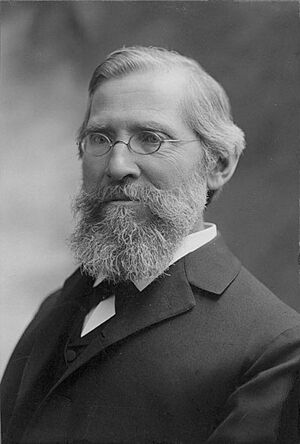Alexander Alexandrovich Chuprov facts for kids
Alexander Alexandrovich Chuprov (born February 18, 1874, in Mosalsk, Russia – died April 19, 1926, in Geneva, Switzerland) was an important Russian statistician. He focused on mathematical statistics, how to study information from samples, and the study of human populations, called demography.
Chuprov grew up in Moscow, where his father, Alexander Ivanovich Chuprov, was a well-known economist and statistician. Following in his father's footsteps, Alexander Alexandrovich studied at Moscow University. He graduated in 1896 with a paper on how probability theory forms the basis of statistics.
From 1897 to 1901, Chuprov continued his studies in Germany, focusing on political economy. While there, he became good friends with another statistician, Ladislaus Bortkiewicz. This friendship would later influence his work. After returning to Russia, he started teaching statistics at the St. Petersburg Polytechnical Institute, where he worked until 1917.
Chuprov often traveled abroad to use different libraries for his research. In June 1917, he went to Stockholm, Sweden. While he was away, the Bolshevik Revolution happened in Russia. He planned to go back, but health issues and money problems kept him from returning.
In 1919, he became the director of a statistical office in Stockholm. Later, in 1920, he moved to Dresden, Germany, where he spent a lot of time writing. In 1925, he took a job at the Russian College in Prague, but sadly, he passed away the next year.
What Chuprov Did
Chuprov was very important both as a teacher and as a writer. The courses he created for the St. Petersburg Polytechnic Institute were very modern. His book on the theory of statistics was also widely used and respected. One of his best students was Oskar Anderson, who also became a famous statistician.
Chuprov's work was shaped by Bortkiewicz's ideas on statistical theory. His father also influenced him by encouraging the use of statistics to understand social conditions in Russia. By 1910, Chuprov was writing about using random sampling to collect information. This was similar to the work of Arthur Lyon Bowley in England.
Chuprov's early work on sampling was not very mathematical. However, in the 1920s, he developed a special formula. This formula helps decide the best way to choose samples in a study. This same idea was later rediscovered by Jerzy Neyman in 1934. Chuprov also studied populations and how they change over time, which is called demographic research.
Chuprov tried to connect different ways of thinking about statistics. He looked at the ideas from Russian mathematicians and English biometricians. He was interested in the work of Karl Pearson from Britain. Chuprov and his student Oskar Anderson even published articles in Pearson's journal, Biometrika.
For a short time, Chuprov was well-known in Britain. In 1921, a famous economist named John Maynard Keynes mentioned him. Keynes listed Chuprov alongside Andrey Markov and Pafnuty Chebyshev as great Russian statisticians. However, as new statistical methods developed, Chuprov's work became less known. He continued to have a lasting impact in Scandinavia, where he published many papers.
See Also


